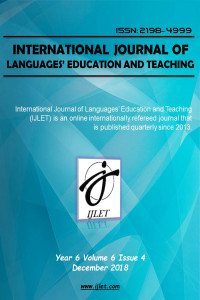Abstract
Writing is perceived as a difficult activity as it requires different competencies and abilities. Writing in a foreign language context is considered to be more difficult and needs special instruction. Considering today’s students’ interests and competence in information and communication (ICT) technologies, it becomes obvious that traditional writing instruction needs to be modified. This study suggests a new process writing model which is comprised of stages such as surfing, organizing, composing, revising, recomposing, and publishing. It is recommended that various online and offline tools, software, applications and web sites can be integrated in the process. The primary aim with this technology-enhanced learning environment is to involve students in the writing process in an active way by making them use various digital tools in and out of the class and thus making them take a positive attitude towards writing. The study concludes that traditional pen-and-paper foreign language classrooms can be transformed into digital writing classes through integrating some digital tools into the suggested stages of the process. It is thought that this new digital writing process will help digital natives improve their writing skills as well as breaking down their prejudices towards foreign language writing.
References
- Brown, H. D. (2001). Teaching by principles. Addison Wesley Longman, Inc.
- Candlin, C. N., & Hyland, K. (2014). Writing: Texts, processes and practices. Routledge.
- Carolyn, F. (2015). The Digital Writing Process. Retrieved from https://www.edutopia.org/discussion/digital-writing-process on September 10, 2018.
- DeVoss, D. N., Eidman-Aadahl, E., & Hicks, T. (2010). Because digital writing matters: Improving student writing in online and multimedia environments. John Wiley & Sons.
- Partnership for 21st Century Skills (P21). (2009). Framework for 21st century learning. Tucson, AZ: Author. Retrieved from: http://www.p21.org/storage/documents/docs/P21_framework_0816.pdf on September 10, 2018.
- Ventimiglia, P., & Pullman, G. (2016). From written to digital: The new literacy. EDUCAUSE Review. March, 7.
- Weigle, S. (2009). Assessing writing. Cambridge University Press.
- White, R., & Arndt, V. (1991). Process writing. London: Longman.
Abstract
Writing is perceived as a difficult activity as it requires different competencies and abilities. Writing in a foreign language context is considered to be more difficult and needs special instruction. Considering today’s students’ interests and competence in information and communication (ICT) technologies, it becomes obvious that traditional writing instruction needs to be modified. This study suggests a new process writing model which is comprised of stages such as surfing, organizing, composing, revising, recomposing, and publishing. It is recommended that various online and offline tools, software, applications and web sites can be integrated in the process. The primary aim with this technology-enhanced learning environment is to involve students in the writing process in an active way by making them use various digital tools in and out of the class and thus making them take a positive attitude towards writing. The study concludes that traditional pen-and-paper foreign language classrooms can be transformed into digital writing classes through integrating some digital tools into the suggested stages of the process. It is thought that this new digital writing process will help digital natives improve their writing skills as well as breaking down their prejudices towards foreign language writing.
References
- Brown, H. D. (2001). Teaching by principles. Addison Wesley Longman, Inc.
- Candlin, C. N., & Hyland, K. (2014). Writing: Texts, processes and practices. Routledge.
- Carolyn, F. (2015). The Digital Writing Process. Retrieved from https://www.edutopia.org/discussion/digital-writing-process on September 10, 2018.
- DeVoss, D. N., Eidman-Aadahl, E., & Hicks, T. (2010). Because digital writing matters: Improving student writing in online and multimedia environments. John Wiley & Sons.
- Partnership for 21st Century Skills (P21). (2009). Framework for 21st century learning. Tucson, AZ: Author. Retrieved from: http://www.p21.org/storage/documents/docs/P21_framework_0816.pdf on September 10, 2018.
- Ventimiglia, P., & Pullman, G. (2016). From written to digital: The new literacy. EDUCAUSE Review. March, 7.
- Weigle, S. (2009). Assessing writing. Cambridge University Press.
- White, R., & Arndt, V. (1991). Process writing. London: Longman.
Details
| Primary Language | English |
|---|---|
| Subjects | English As A Second Language |
| Journal Section | Research Article |
| Authors | |
| Publication Date | December 30, 2018 |
| Published in Issue | Year 2018 Volume: 6 Issue: 4 |


